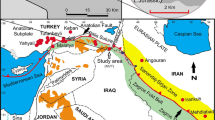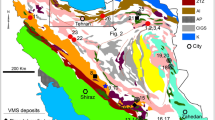Abstract
The Angouran Zn-(Pb–Ag) deposit, Zanjan Province, NW Iran, is located within the central Sanandaj-Sirjan Zone of the Zagros orogenic belt. The deposit has proven and estimated resources of 4.7 Mt of sulfide ore at 27.7% Zn, 2.4% Pb, and 110 g/t Ag, and 14.6 Mt of oxidized carbonate ores at 22% Zn and 4.6% Pb. It is hosted by a metamorphic core complex that is unconformably overlain by a Neogene volcanic and evaporite-bearing marine to continental sedimentary sequence. The sulfide orebody, precursor to the significant nonsulfide ores, is located at the crest of an open anticline at the contact between Neoproterozoic to Cambrian footwall micaschists and hanging wall marbles. 40Ar–39Ar data on muscovite from mineralized and unaltered footwall micaschists suggest a rapid Mid-Miocene exhumation of the metamorphic basement (∼20 Ma) and yield an upper age constraint for mineralization. The fine-grained sulfide ore is massive, replacive, often brecciated, clearly postmetamorphic and dominated by Fe-poor sphalerite, with minor galena, pyrite, anhydrite, quartz, muscovite, dolomite, and rare calcite. Sphalerite contains Na–Ca–Cl brine inclusions (23–25 mass% total dissolved solids) with homogenization temperatures of 180–70°C. Fluid inclusion chemistry (Na–K–Li–Ca–Mg–Cl–Br), ore geochemistry, S, and Pb isotope data suggest that the Angouran sulfide ore formed by the interaction of modified, strongly evaporated Miocene seawater and the lithotypes of an exhumed metamorphic core complex. Minor contributions of metals from Miocene igneous rocks cannot be excluded. Mineralization occurred in a collisional intra-arc setting with high heat flow, probably during the transition from an extensional to a compressional regime. The Angouran deposit may represent a new type of low-temperature carbonate-hosted Zn–Pb ore that is distinct from Mississippi Valley type and sedimentary-exhalative deposits.









Similar content being viewed by others
References
Alavi M (1994) Tectonics of the Zagros orogenic belt of Iran: new data and interpretation. Tectonophysics 229:211–238
Alinia F (1989) Mineralogy and genesis of Zn–Pb deposit, Anguran, northwest Iran. Abstracts of the 28th International Geological Congress, Washington, DC, (abstract 28/1), p 31
Al Ganad I, Lagny P, Lescuyer JL, Ramboz C, Touray JC (1994) Jabali, a Zn–Pb-(Ag) carbonate-hosted deposit associated with Jurassic rifting in Yemen. Miner Depos 29:44–56
Annels AE, O’Donovan G, Bowles M (2003) New ideas concerning the genesis of the Angouran Zn–Pb deposit, NW Iran. Abstracts of the 26th Mineral Deposits Studies Group, University of Leicester, Leicester, pp 11–12
Asadi HH, Hale M (2001) A predictive GIS model for mapping potential gold and base metal mineralization in Takab area, Iran. Comput Geosci 27:901–912
Asadi HH, Voncken JHL, Hale M, Kuhnel RA (1999) Petrography, mineralogy and geochemistry of the Zarshuran Carlin-like gold deposit. Miner Depos 35:656–671
Babakhani AR, Ghalamghash J (1990) Geological map of Iran, 1:100,000 series sheet Takht-e-Soleiman. Geological Survey of Iran, Tehran
Banks DA, Green R, Cliff RA, Yardley BWD (2000) Chlorine isotopes in fluid inclusions: determination of the origin of salinity in magmatic fluids. Geochim Cosmochim Acta 64:1785–1789
Bariand P, Issakhanian V, Sadrzadeh M (1965) Preliminary metallogenetic map of Iran. Geological Survey of Iran Report No. 7, Tehran, pp 1–50
Böhlke JK, Irwin JJ (1992) Laser microprobe analyses of Cl, Br, I and K in fluid inclusions: implications for sources of salinity in some ancient hydrothermal fluids. Geochim Cosmochim Acta 56:203–225
Borg G, Daliran F (2004) Hypogene and supergene formation of sulphides and non-sulphides at the Angouran high-grade zinc deposit, NW-Iran. In: Abstract volume of Geoscience Africa 2004. University of the Witwatersrand, Johannesburg, pp 69–70
Burnol L (1968) Contribution a l’etude des gisements de plomb et zinc de l’Iran. Essais de classification paragenetique. Geological Survey of Iran Report No. 11, pp 1–113
Cooke DR, Bull SW, Large RR, McGoldrick PJ (2000) The importance of oxidized brines for the formation of Australian Proterozoic stratiform sediment-hosted Pb–Zn (Sedex) deposits. Econ Geol 95:1–18
Daliran F, Borg G (2003) A preliminary appraisal of the non-sulfide zinc deposit of Angouran, north-west Iran. In: Eliopoulos D et al (eds) Mineral exploration and sustainable development. Millpress, Rotterdam, pp 65–68
Daliran F, Borg G (2005) Characterisation of the nonsulfide zinc ore at Angouran, northwestern Iran, and its genetic aspects. In: Jingwen M, Bierlein FP (eds) Mineral deposit research: meeting the global change, vol 2. Springer, Berlin Heidelberg New York, pp 913–916
Daliran F, Hofstra A, Walther J, Stüben D (2002) Agdarreh & Zarshuran SRHDG deposits, Takab region, NW-Iran. Annual meeting of the Geological Society of America, Denver, pp 63–68
Damm B (1968) Geologie des Zendan-i Suleiman und seiner Umgebung südöstliches Balqash-Gebirge Nordwest-Iran. Beiträge zur Archäologie und Geologie des Zendan-i Suleiman, Teil 1. Franz Steiner Verlag, Wiesbaden, pp 1–52
Doe BR, Zartman RE (1979) Plumbotectonics, the Phanerozoic. In: Barnes HL (ed) Geochemistry of hydrothermal ore deposits, 2nd edn. Wiley, New York, pp 22–70
Fontes JC, Matray JM (1993) Geochemistry and origin of formation brines from the Paris Basin, France. 1. Brines associated with Triassic salts. Chem Geol 109:149–175
Gazanfari F (1991) Metamorphic and igneous petrogenesis in NE of Takab with special regard to zinc mineralization in the Angouran mine. Unpubl. Master's thesis, University of Teheran (in Farsi)
Ghazban F, McNutt RH, Schwarcz HP (1994) Genesis of sediment-hosted Zn–Pb–Ba deposits in the Irankuh district, Esfahan area, west-central Iran. Econ Geol 89:1262–1278
Gilg HA (1996) Fluid inclusion and isotope constraints on the genesis of high-temperature carbonate-hosted Pb–Zn–Ag deposits. Society of Economic Geologists Special Publication No. 4, pp 501–514
Gilg HA, Boni M (2004) Stable isotope studies on Zn and Pb carbonates: could they play a role in mineral exploration? In: Pecchio M et al (eds) Applied mineralogy, developments in science and technology, vol 2. ICAM-BR, São Paulo, pp 781–784
Gilg HA, Allen C, Balassone G, Boni M, Moore F (2003) The 3-stage evolution of the Angouran Zn “oxide”-sulfide deposit, Iran. In: Eliopoulos D et al (eds) Mineral exploration and sustainable development. Millpress, Rotterdam, pp 77–80
Glennie KW (2000) Cretaceous tectonic evolution of Arabia’s eastern plate margin: a tale of two oceans. In: Middle East models of Jurassic/Cretaceous carbonate systems. SEPM Special Publication No. 69, pp 9–20
Goodfellow WD, Lydon JW, Turner RJW (1993) Geology and genesis of stratiform sediment-hosted (SEDEX) zinc–lead–silver sulfide deposits. In: Kirkham RV, Sinclair WD Thorp RI, Duke JM (eds) Mineral deposit models. Geological Association of Canada Special Paper No. 40, pp 201–252
Grandia F, Canals A, Cardellach E, Banks DA, Perona J (2003) Origin of ore-forming brines in sediment-hosted Zn–Pb deposits of the Basque-Cantabrian basin, Northern Spain. Econ Geol 98:1397–1411
Haditsch JG (1990) Genese der Silizifierung iranischer Blei-Zink-Lagerstaetten. Berg Huettenmann Monatsh 135:197–203
Hamdi B (1995) Precambrian–Cambrian deposits in Iran. In: Hushmandzadeh A (ed) Treatise of the geology of Iran, vol 20. Geological Survey of Iran, Tehran, pp 1–535
Hirayama K (1968) Geological study on the Anguran Mine, northwestern part of Iran. Geological Survey of Japan Report No. 226, pp 1–26
Hitzman MW, Reynolds NA, Sangster DF, Allen CR, Carman CE (2003) Classification, genesis, and exploration guides for nonsulfide zinc deposits. Econ Geol 98:685–714
Houtum-Schindler A (1881) Neue Angaben über die Mineralreichthümer Persiens und über die Gegend westlich von Zendjan. Jb kaiserl kgl Geol Reichsanst 31:169–190
Kharaka YK, Mariner RH (1989) Chemical geothermometers and their application to formation waters from sedimentary basins. In: Naeser ND, McCulloh TH (eds) Thermal history of sedimentary basins. Springer, Berlin Heidelberg New York, pp 99–117
Ladame G (1945) Les ressources métallifères de l’Iran. Schweiz. Mineral Petrogr Mitt 25:165–298
Lancelot J, Orgeval JJ, Fariss K, Zadeh H (1997) Lead isotope signature of major Iranian Zn–Pb ore deposits (Anguran, Duna, Irankuh, Mahdiabad, Nakhlak). Terra Nova 9(Abstr Suppl)1:550
Leach DL, Sangster DF (1993) Mississippi valley-type lead–zinc deposits. In: Kirkham RV, Sinclair WD, Thorp RI, Duke JM (eds) Mineral deposit models. Geological Association of Canada Special Paper No. 40, pp 289–314
Lotfi M, Karimi M (2004) Geology, mineralogy and ore-genesis of Bayche–Bagh (Ni–Co–As–Bi and base metals) vein-type deposit (NW-Zanjan, Iran). Abstract volume of the 32nd International Geological Congress (part 2, abstract 215-34), p 999
Maanijou M (2002) Proterozoic metallogeny of Iran. Abstracts of the international symposium on the metallogeny of Precambrian shields, Kiev, 13–26 September 2002, p 2
Machel HG, Krouse HR, Sassen R (1995) Products and distinguishing criteria of bacterial and thermochemical sulfate reduction. Appl Geochem 10:373–389
Megaw PKM (1998) Carbonate-hosted Pb–Zn–Ag–Cu–Au replacement deposits: an exploration perspective. In: Lentz DR (ed) Mineralized intrusion-related skarn systems. Mineralogical Association of Canada Short Course Series No. 26, Quebec, pp 337–358
Mehrabi B, Yardley BWD, Cann JR (1999) Sediment-hosted disseminated gold mineralization at Zarshuran, NW Iran. Miner Depos 34:673–696
Minorskij V (1955) Abu-Dulaf Mis’ar Ibn Muhalhil’s Travels in Iran, Arabic text with an English translation and commentary. Cairo University Press, Cairo
Naumann E (1961) Geographische und geologische Einordnung. Teheran Forsch 1:15–32
Oakes CS, Bodnar RJ, Simonson JM (1990) The system NaCl-CaCl2-H2O. I. The ice liquidus at 1 atm total pressure. Geochim Cosmochim Acta 54:603–610
Ohmoto H, Goldhaber MB (1997) Sulfur and carbon isotopes. In: Barnes HL (ed) Geochemistry of hydrothermal ore deposits, 3rd edn. Wiley, New York, pp 517–611
Purdy JW, Jäger E (1976) K–Ar ages on rock-forming minerals from the Central Alps. Mem Ist Geol Mineral Univ Padova 30:1–31
Rahimpour-Bonab H, Kalantarzadeh Z (2005) Origin of secondary potash deposits; a case from Miocene evaporites of NW central Iran. J Asian Earth Sci 25:157–166
Rahimpour-Bonab H, Kazemi H (2003) Geology, mineralogy and genesis of the Gharah-Gol Boron deposit, SW of Zanjan, Iran. J Sci Univ Tehran 29:1–23
Sadeghi M (2003) Mineralogy, geochemistry and fluid inclusion study of Anguran deposit, NW Iran. Abstracts of the 13th V.M. Goldschmidt Conference, Kurashiki, 7–12 September 2003, A406
Sass-Gustkiewicz M (1996) Internal sediments as a key to understanding the hydrothermal karst origin of the Upper Silesian Zn–Pb ore deposits. In: Sangster DF (ed) Carbonate-hosted lead–zinc deposits. Society of Economic Geologists Special Publication No. 4, pp 171–181
Steiger RH, Jäger E (1977) Subcommission on geochronology: convention on the use of decay constants in geo- and cosmochronology. Earth Planet Sci Lett 36:359–362
Stockli DF, Hassanzadeh J, Stockli LD, Axen G, Walker JD, Dewane TJ (2004) Structural and geochronological evidence for Oligo-Miocene intra-arc low-angle detachment faulting in the Takab-Zanjan area, NW Iran. Abstr Programs Geol Soc Am 36(5):319
Velasco F, Herrero JM, Yusta I, Alonso JA, Seebold I, Leach D (2003) Geology and geochemistry of the Reocín zinc–lead deposit, Basque-Cantabrian Basin, Northern Spain. Econ Geol 98:1371–1396
Verma SP, Santoyo E (1997) New improved equation for Na/K, Na/Li and SiO2 geothermometers by outlier detection and rejection. J Volcanol Geotherm Res 79:9–23
Viets JG, Hofstra AH, Emsbo P (1996) Solute composition of fluid inclusions in sphalerite from North American and European Mississippi-valley type ore deposits: ore fluids derived from evaporated seawater. Society of Economic Geologists Special Publication No. 4, pp 465–482
Walter LM, Stueber AM, Huston TJ (1990) Br–Cl–Na systematics in Illinois basin fluids: constraints on fluid origin and evolution. Geology 18:315–318
Zhang YG, Frantz JD (1987) Determination of the homogenization temperatures and densities of supercritical fluids in the system NaCl-KCl-CaCl2 using synthetic fluid inclusions. Chem Geol 64:335–350
Acknowledgements
We are indebted to the Iranian Zinc Mines Development Company (IZMDC), R. Mohammadi Niaei, and S. Modabberi for generous help during field work. M. Sadeghi provided some samples during the early stage of this study. We would like to thank G. Chi (fluid inclusions) and M. Heizler (40Ar–39Ar chronology). Alwyn Annels and Farahnaz Daliran are acknowledged for discussions on the genesis of the Angouran deposits. M. Parente determined the fossils in the Qom limestones. The careful reviews by G. Borg and B. Lehmann are gratefully acknowledged.
Author information
Authors and Affiliations
Corresponding author
Additional information
Editorial handling: B. Lehmann
Rights and permissions
About this article
Cite this article
Gilg, H.A., Boni, M., Balassone, G. et al. Marble-hosted sulfide ores in the Angouran Zn-(Pb–Ag) deposit, NW Iran: interaction of sedimentary brines with a metamorphic core complex. Miner Deposita 41, 1–16 (2006). https://doi.org/10.1007/s00126-005-0035-5
Received:
Accepted:
Published:
Issue Date:
DOI: https://doi.org/10.1007/s00126-005-0035-5




